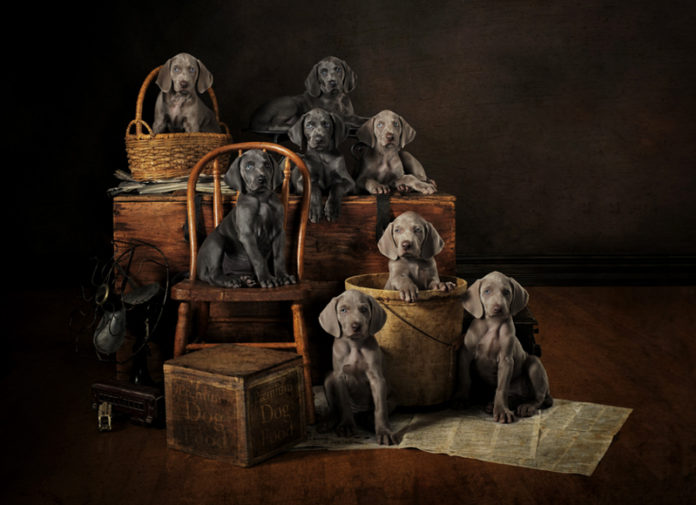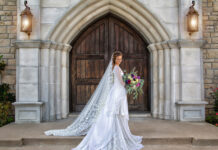by Margaret Bryant
Who doesn’t love the smell of puppy breath? Puppies are dear, sweet, adorable bundles of cuteness. So how easy are they to photograph? Puppies can come in litters usually from breeders or rescue groups. Individual puppies usually come from individual owners. Below are some tips on photographing puppies.
Unless you just want a pile of sleeping or nursing puppies, it is probably better to wait until the puppies are at least 7 weeks old before photographing them. By then their personalities should be starting to come out and you can tell them apart by personality, not just by fur color or collar color. Let the owner or breeder advise if the personalities of the puppies are starting to show.
Eight weeks or so is when the breeder/rescue group is probably letting the puppies go to their new homes. Make sure the puppies are healthy and don’t show any signs of illness. The puppies should have at least their first round of vaccinations. You want to make sure they have had their vaccinations before you bring them into the studio or any other location other than their home.
The key reason for making sure they have had their shots is Parvo. Puppies are more susceptible to Parvo since they do not have any immunity to it. It is a horrible, horrible disease and many puppies do not survive. So as a photographer, why should you care? Parvo can live in the soil for a very long time. If a puppy has Parvo, your studio will need an extraordinary level of cleaning. I usually have the owner carry the puppies into my studio because I have no control over the dogs that may have visited the outside of my studio and might have left the virus outside. But I do have control over my studio and the grassy area in the back. Parvo is a very serious disease and you do not want to get involved with it (adult dogs are vaccinated for Parvo and it is much less of a concern with adult dogs).
Then what? If you are dealing with a litter of puppies, you should have one handler for every two dogs. As the photographer, you are not responsible for handling any puppies. I once photographed a litter of 13 rescue puppies. To say it was crazy is an understatement! I wouldn’t have been able to do it had the rescue group not brought along enough people to help. Don’t try to do it alone, you will definitely need help.
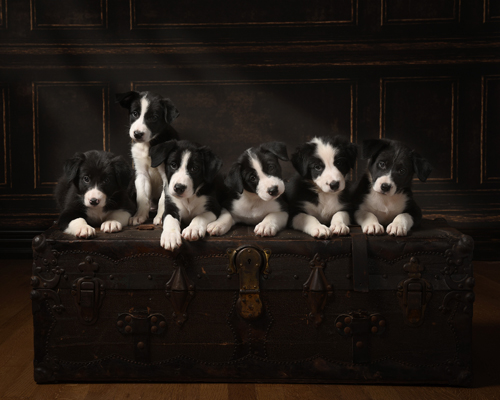
Every puppy is going to have a different activity level. They will each play for a while and then fall deeply asleep. If you have a litter of puppies, they will, of course, do this at different rates. You will always have some puppies that are awake and playing, and some that are sleeping. Know this going in and do not get frustrated.
If you are talking about a single puppy rather than a group of puppies, the owner will probably know what time of day the puppy is most active. Start the photo session during the time the puppy is most active. The puppy will play and will tire out in a relatively short period of time so you can get the sleepy puppy shots too!
Puppies will pee and poop so be ready to clean up their messes. It might make the session easier if the owner were to bring a crate or an x-pen to contain the puppies when you are not photographing them.
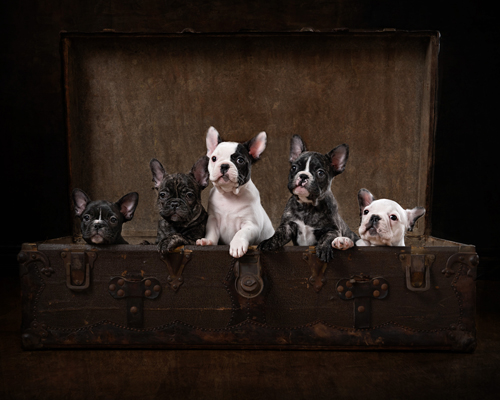 Once again, remember you need a lot of patience. Puppies are very limp and don’t understand what you want them to do. You can’t really pose a puppy; you can only hold them in place, especially if they are sleepy. Sometimes you can mold them into position. But don’t count on it. “Limp puppies” are the key words here!
Once again, remember you need a lot of patience. Puppies are very limp and don’t understand what you want them to do. You can’t really pose a puppy; you can only hold them in place, especially if they are sleepy. Sometimes you can mold them into position. But don’t count on it. “Limp puppies” are the key words here!
If the breeder is selling the puppies or the rescue group is putting the puppies out for adoption, you will likely be photographing the pups individually as well as in groups. If you are photographing them individually, use a dry erase board with the puppy’s name on it, and photograph it before each puppy. Breeders usually tell the puppies apart by having different colored ribbons or collars around their necks, or different colored nail polish on their nails. When you are editing your images, you might not be able to see the ribbon or the collar around their neck, or the color on the nails and the dry erase board is a life saver to help tell the puppies apart.
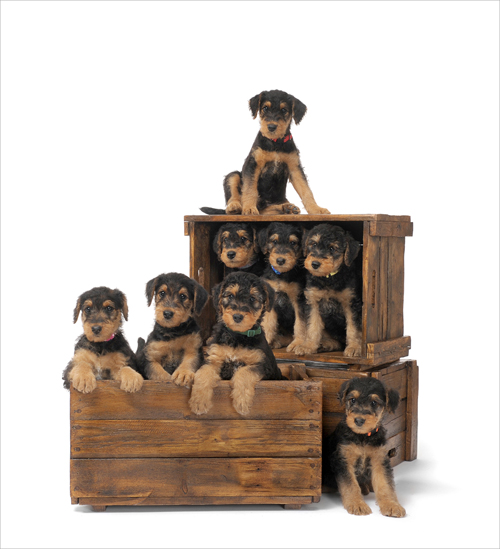 The individual puppies will probably not do much. You can usually prop them up like they are sitting. If they are active perhaps you can engage them with a toy. Tug toys usually work well. But do not tire them out too soon!
The individual puppies will probably not do much. You can usually prop them up like they are sitting. If they are active perhaps you can engage them with a toy. Tug toys usually work well. But do not tire them out too soon!
If you are doing a group shot, have in your mind what you want the group shot to be. Will they be on a piece of furniture? Will they be on the floor? Are you setting up a scene they will be in? Have a plan and have alternates in case your original plan doesn’t work. You usually have that one puppy who is very active when the others are ready for a nap. Have a plan. Puppies “raised up” on something (like a sofa) or “in” something (like a tub or a trunk) will make things easier. Puppies are usually reluctant to jump down or jump out. Remember to always keep the puppies safe so they do not get hurt if they do decide to jump!
Sometimes you want more than just a sofa or a trunk to use with the puppies and you want to put together a little “set” to put the pups in. Here is where I might recommend planning a composite photograph. Create the composite by photographing a few puppies in the scene at a time. It is easier to get a few puppies to look at you than it is to get a lot of puppies to look at you. The puppies being placed further apart also adds to the difficulty.
If you decide to have the puppies on the floor, you can put together a puppy row or a puppy pile. Because you have to corral the pups to keep them in place, this pose is better when the pups are starting to get tired. Then when they are totally pooped out, you can arrange a pile of sleeping puppies. They are pretty limp when they are sleeping so you can pose them most any way you want. The job of “sleeping puppy stylist” is a lot of fun!
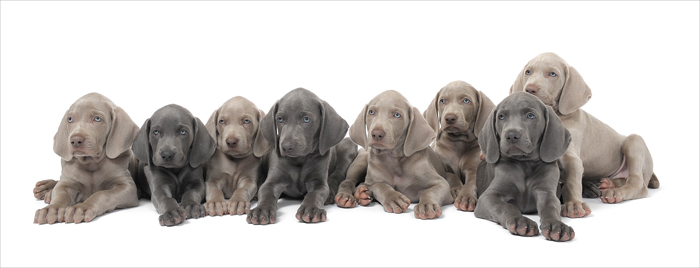
If you are photographing an individual puppy in its forever home, all of the preceding suggestions apply. I would add to this doing some shots with the owner, and most importantly, photographing the puppy against an object of known size. The owner is going to forget how tiny the puppy once was and this will help in remembering. The object might be the owner’s shoes, or some other object that has meaning to the owner. It will be a great remembrance for the owner.
A product I offer is a year in the life of a puppy that includes four photo sessions spaced throughout the year and an album. I photograph the puppy as it grows up using the same props each session so it is easy to see how the puppy is growing and changing. At the end of the first year, I assemble an album with page spreads showing the puppy growing up. It’s always a big hit.
Prop suggestions for the growing sessions might be the object of known size mentioned before, a large chair, a tennis ball, or a plush toy. You can photograph the puppy playing with the plush toy, or lying down with his head on it. When you are done with each session, someone should keep the plush toy out of reach of the puppy. In much less than a year’s time the plush toy is likely to be torn apart if you let the puppy get to it. If you want a sequence showing the gradual demise of the toy, I suggest you have another toy that is kept new for a separate sequence to show the puppy’s growth.
One session I had in the past year was a Portuguese Water Dog puppy. Each session I would photograph the dog with his harness. In the first session, he wore the tiny harness and it was a little loose. By the time of the last session almost a year later, he wore the harness like a helmet. Yes, he had grown that much larger! Another popular pose is running in profile. I assemble those for an album spread or a wide wall portrait showing a sequence of the puppy running (in my case against a white background), and the puppy is smaller on the left and largest on the right, all of them running. Again, these images are always a big hit.
In conclusion, have lots of patience. If you have a litter of puppies, have a lot of help. Remember puppies are pretty flexible and limp and won’t be able to do much of anything you want except to look cute. And isn’t that about all we are realistically asking for?
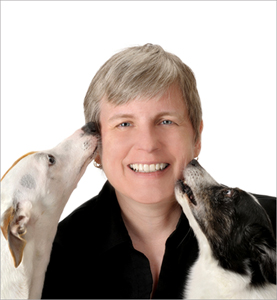 Margaret Bryant is an award-winning photographer who specializes in photographing dogs and their people. Her style is simple, original and authentic and often shows the humor and whimsy of dogs. Starting her business in 1998, Margaret has specialized in dogs and their humans from the very start. She teaches a class on “Dog and Pet Photography” at the Texas School of Professional Photography.
Margaret Bryant is an award-winning photographer who specializes in photographing dogs and their people. Her style is simple, original and authentic and often shows the humor and whimsy of dogs. Starting her business in 1998, Margaret has specialized in dogs and their humans from the very start. She teaches a class on “Dog and Pet Photography” at the Texas School of Professional Photography.



